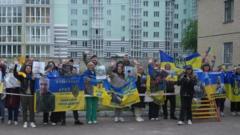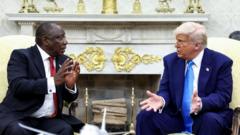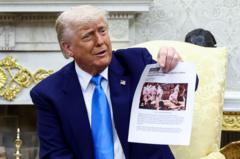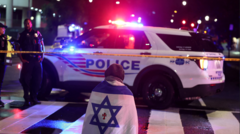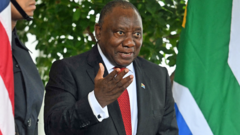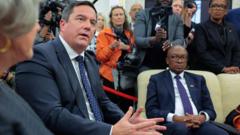President Trump claims a remote South African road serves as a burial site for Afrikaner farmers murdered, prompting local responses that contest his narrative. The crosses along the P39-1 were a temporary memorial for two murdered farmers, highlighting the complex issues of race relations and crime in South Africa.
Misleading Claims About South African Crosses: The Truth Behind Trump's Video

Misleading Claims About South African Crosses: The Truth Behind Trump's Video
President Trump's sensational portrayal of a South African road as a 'burial site' sparks local outrage; the truth reveals a community grappling with tragic losses rather than political narratives.
The P39-1, a commonplace stretch of highway connecting Newcastle and Normandein in South Africa's KwaZulu-Natal province, gained unexpected global attention this week after President Donald Trump claimed it was a 'burial site' during a confrontation with South African President Cyril Ramaphosa. In a video broadcast from the Oval Office, Trump asserted a narrative of persecution against white farmers, repeatedly referencing a "burial site" adorned with white crosses, mistakenly attributing it to recent murders of Afrikaners in South Africa.
Contrary to Trump's claims, local residents express shock at the mischaracterization. The crosses, initially displayed as a temporary memorial in the aftermath of the 2020 murders of Glen and Vida Rafferty—Roland Collyer’s aunt and uncle—symbolized the tragedy within the farming community. Roland Collyer, an Afrikaner farmer, explains that the crosses represented lives lost to a wave of farm murders which had sparked community outcry.
Rob Hoatson, a neighbor of the Raffertys, highlighted that the installation of the crosses was purely a memorial gesture, organized to draw media attention and not indicative of a permanent site. He remarked on Trump's tendency to exaggerate while acknowledging the importance of the memorial's message.
Despite experiencing fear and rising crime rates—South Africa witnesses over 26,000 murders annually, predominantly among black citizens—Collyer shares his resolve to remain in the country his family has cultivated for generations. He expresses his sentiments about the growing tension amidst the racial context, while emphasizing the potential for unity among South Africans of all backgrounds.
Other locals, such as 63-year-old Bethuel Mabaso, express disbelief regarding Trump's assertions, asserting the peace that embodies their community. He recounts how the area has remained tranquil following the tragedies, categorically denying claims of targeting against farmers.
This moment serves as a revelation of the narratives and realities shaping perceptions of race relations in South Africa. It highlights the delicate balance between acknowledging the past's injustices and fostering future collaborations among different racial communities. As misunderstandings proliferate globally, local voices emphasize a need for greater engagement and the understanding inherent to forging a shared future.



